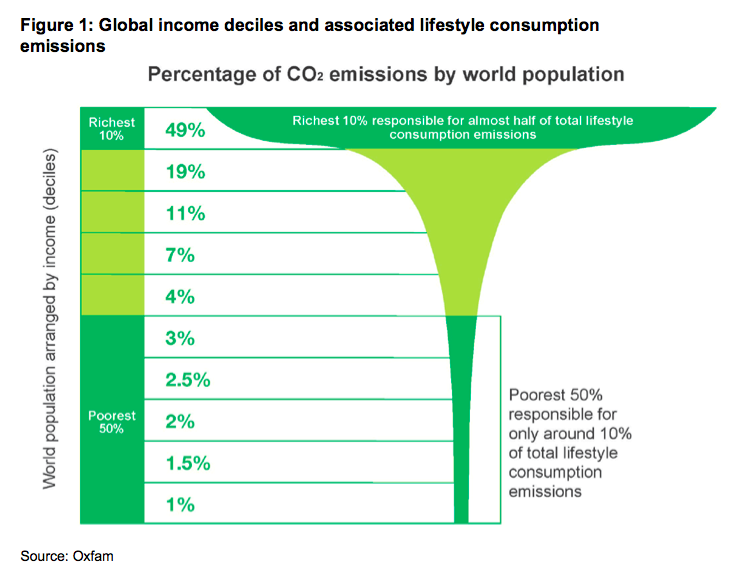
13 Dec, 2015
World’s richest 10% produce half of global carbon emissions – Oxfam report
London, 2 December 2015, (Oxfam media release) – The poorest half of the world’s population – 3.5 billion people – is responsible for just 10 percent of carbon emissions, despite being the most threatened by the catastrophic storms, droughts, and other severe weather shocks linked to climate change. These are the findings of a new Oxfam report, released during the ongoing climate talks in Paris, which also shows the world’s richest 10 percent produce around half of all emissions.
The Oxfam report, “Extreme Carbon Inequality,” provides new estimates of the lifestyle consumption emissions of rich and poor citizens in different countries. While negotiators might be working to reach an agreement based on the total emissions produced by their respective countries, this analysis helps dispel the myth that citizens in rapidly developing countries are somehow most to blame for climate change. While emissions are rising fastest in developing countries, much of this is for the production of goods consumed in other countries, meaning that the emissions associated with the lifestyle of the vast majority of their citizens are still far lower than their counterparts in developed countries.

Oxfam’s head of food and climate policy, Tim Gore, said: “Climate change and economic inequality are inextricably linked and together pose one of the greatest challenges of the 21st century. Paris must be the start of building a more human economy for all – not just for the ‘haves,’ the richest and highest emitters, but also the ‘have-nots,’ the poorest people who are the least responsible for and most vulnerable to climate change.”
The report, authored by Gore, makes clear the extent of this inequality in emissions responsibility – globally, within and between countries. For example:
- Someone in the richest one percent of the world’s population uses 175 times more carbon on average than someone from the bottom 10 percent.
- Someone in the richest 10 percent of citizens in India uses on average just one quarter of the carbon of someone in the poorest half of the population of the United States.
- The emissions of someone in the poorest half of the Indian population are on average just one-twentieth those of someone in the poorest half of the US population.
- The total emissions of the poorest half of the population of China, around 600 million people, are only one-third of the total emissions of the richest 10 percent in the US, some 30 million people.
“Rich, high emitters should be held accountable for their emissions, no matter where they live. But it’s easy to forget that rapidly developing economies are also home to the majority of the world’s very poorest people and while they have to do their fair share, it is rich countries that should still lead the way,” said Gore.
According to the report, the only people who benefit from the status quo and who stand to gain from a weak deal in Paris is a select group of billionaires, who have made many of their fortunes in the fossil fuel industry. Tackling the economic inequality that these ‘carbon barons’ thrive on is critical both to ending extreme poverty and fighting climate change.
As a recent World Bank report showed, the poorest are often the most vulnerable and least prepared to cope with the effects of climate change, regardless of national borders. Droughts, floods, and superstorms have hit both countries like the United States and the Philippines. Women, especially those in rural communities, are most at risk, since they often depend on agriculture and have few other opportunities to make a living.
“Extreme carbon inequality has to be capped. Any deal must keep alive the possibility of holding global warming at 1.5 degrees Celsius, and provide a major boost in funding to help the poorest and most vulnerable communities adapt to climate change,” Gore continued.
Oxfam is also calling for the Paris deal to recognize the need to address loss and damage from the effects of climate change to which it is not possible to adapt, as well as ensure that all climate projects and actions respect human rights and gender equality.
Click here to download the report FREE: Extreme Carbon Inequality



Liked this article? Share it!